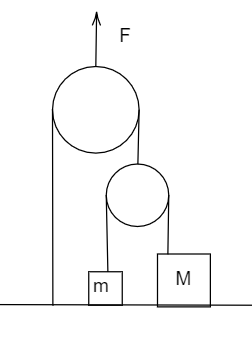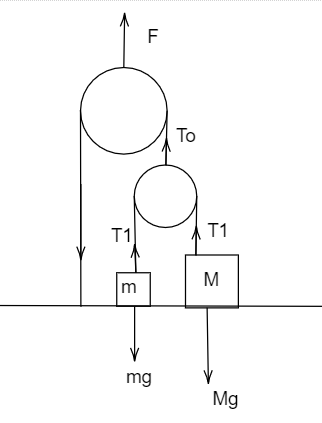
Two blocks of mass

(A)
(B)
(C)
(D)
Answer
156k+ views
Hint For lifting a body in an upward direction the upward directing force must be greater than the force acting in the downward direction. Tension in a massless string is the same along its length. We will use this property to solve this question.
Complete Step-by-step solution
Let,
Free body diagram:

The upward force on block m and M is the same as that force is due to tension in the string which is the same across its length as tension in a massless string is the same along its length.
Weights of blocks are,
As
Note As discussed earlier tension along the same massless string will be the same this is an important point to be noted as many students consider tension in both strings different and end up making mistakes due to this mistake there time also got wasted in the examination hall and could get negative marks in the question.
Complete Step-by-step solution
Let,
Free body diagram:

The upward force on block m and M is the same as that force is due to tension in the string which is the same across its length as tension in a massless string is the same along its length.
Weights of blocks are,
As
Note As discussed earlier tension along the same massless string will be the same this is an important point to be noted as many students consider tension in both strings different and end up making mistakes due to this mistake there time also got wasted in the examination hall and could get negative marks in the question.
Recently Updated Pages
JEE Atomic Structure and Chemical Bonding important Concepts and Tips

JEE Amino Acids and Peptides Important Concepts and Tips for Exam Preparation

JEE Electricity and Magnetism Important Concepts and Tips for Exam Preparation

Chemical Properties of Hydrogen - Important Concepts for JEE Exam Preparation

JEE Energetics Important Concepts and Tips for Exam Preparation

JEE Isolation, Preparation and Properties of Non-metals Important Concepts and Tips for Exam Preparation

Trending doubts
Degree of Dissociation and Its Formula With Solved Example for JEE

Geostationary Satellites and Geosynchronous Satellites - JEE Important Topic

Electrical Field of Charged Spherical Shell - JEE

Keplers second law is a consequence of A Conservation class 11 physics JEE_Main

Learn About Angle Of Deviation In Prism: JEE Main Physics 2025

Functional Equations - Detailed Explanation with Methods for JEE

Other Pages
JEE Advanced Chemistry Notes 2025

Electrochemistry JEE Advanced 2025 Notes

Reynold number left R right determines whether or not class 11 physics JEE_Main

JEE Advanced 2025 Revision Notes for Mechanics

List of Fastest Century In IPL - Cricket League and FAQs

NEET 2025: All Major Changes in Application Process, Pattern and More




